
7 Oct, 2013
Early warning: Averting the next looming threat to ASEAN peace & prosperity
Mahidol University, Salaya Campus, Thailand – Regardless of how many highways and airports emerge in ASEAN, or how many telecommunications, single-visa and energy and currency swap deals the ASEAN leaders sign, the real bridges of peace and prosperity will be built only if they can overcome the looming threats of religious/ethnic discord. Discussions at an International Conference on Building Bridges between Buddhism and Islam indicated clearly that the future of ASEAN will depend as much on its religious leaders as on its politicians, technocrats and diplomats, provided they can sideline the respective trouble-makers and allow their far more significant commonalities to prevail over minor philosophical and theological differences.
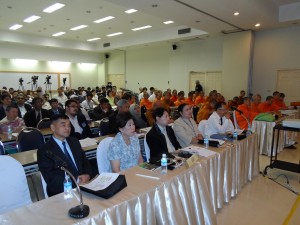 Conference participants at the opening ceremony |
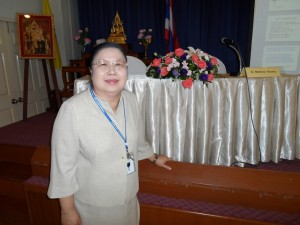 Assoc. Prof. Dr. Wathinee Boonchalaksi, Dean, College Religious Studies, Mahidol University |
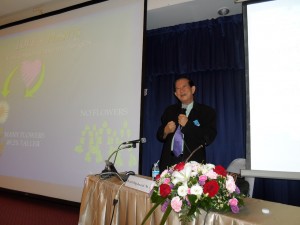 Dr Art Ong Jumsai Na Ayudhya, Director and Chief Administrator, Sathya Sai School |
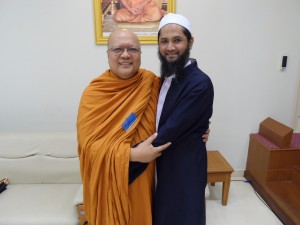 Venerable Phra Methavinairos of the Wat Ratchapradit Sathitmahasimaram Ratchaworavihan and Sittirath Wacharapisudh, the khateeb of Harun mosque, Bangkok |
 Venerable Jayamedho, Vice Dean, Kertaraja Buddhist college, Batu-Malang, Indonesia and Imam Abdul Ahad of the Harun Mosque, Bangkok. |
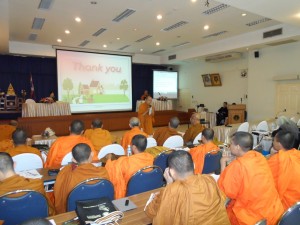 |
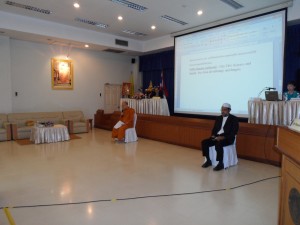 A moment of prayer and reflection marking the closing ceremony. |
 |
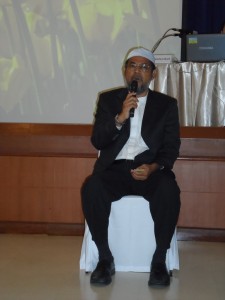 |
Claimed to be the first of its kind in Thailand, the conference was organised by the newly-established International Center for Buddhist-Muslim Understanding at the College of Religious Studies, Mahidol University between 3-4 October 2013. It attracted a diverse cast of 135 participants, with 13 speakers ranging from monks and imams to academics and activists.
In her inaugural remarks, Assoc. Prof. Dr. Wathinee Boonchalaksi, Dean, College Religious Studies, Mahidol University, said the Center had been set up in preparation for the upcoming ASEAN integrated community in 2015 when the combined population of its 10 countries will be 42% Muslim and 40% Buddhist. “The Center seeks to advance Buddhist-Muslim relations from the current state of mere co-existence to the state of understanding through educational and social exchange. This will contribute towards building the ASEAN Socio-Cultural Community (ASCC) which represents the human dimension of ASEAN cooperation and upholding ASEAN commitment to address the region’s aspiration to lift the quality of life of its peoples.”
She added, “As the ASEAN region gains global economic and political importance, Buddhist-Muslim relations will become an increasingly significant issue for building harmonious socio-cultural relations in Southeast Asia amidst new challenges, tensions and conflicts in the region which should not jeopardise peace in the future of the ASEAN community.” There is an urgent need to initiate academic research and social outreach for building constructive relations, promoting understanding and removing misinformation, she said.
Part of the solution
Throughout the conference, there was unanimous agreement that ASEAN’s two dominant religions had to be part of the solution. Beginning their presentations with prayers for peace, several speakers referred to the fact that all humans, regardless of their religion, were the same, born on one planet, aspiring for security and happiness and a better future for their children, and equally affected by crises, be they environmental disasters or terrorist attacks. There was no disagreement about the fundamental religious teachings and their intended outcome, viz., to create sustainable, just and equitable societies. Religious leaders from both sides cited numerous passages from their respective doctrines and scriptures attesting to that. They also discussed techniques to achieve those aims – prayer, meditation, breathing, self-control, mind-control. They all agreed that such cooperative action was necessary not just for the present but also for our children in future.
Hence, the question arose, why all the conflict?
The conference got off to a great start with a brilliant lecture by Dr Art Ong Jumsai Na Ayudhya, Director and Chief Administrator, Sathya Sai School, located in Lop Buri province. His school, he said, focuses on teaching human values not just imparting an education. He said that the world is full of negativity, with politics, economic upheavals and media images feeding conflict and violence, and children had to develop an “immunity to the negativity.” He said getting people to think as one will require them to understand that we live in the same world. “This is our only home. We have no other home to live in. We cannot go live on any other planets. So, why are we quarreling and fighting?”
As a scientist, he said, his brief is to find solutions to problems. For example, he cited the words “I Want Peace.” If the “I” (meaning selfishness, pride and ego) is dropped, followed by “Want” (meaning insatiable desire triggered by consumerism and the demands of economic growth), the only word left is “Peace”. Achieving this peace will mean replacing the pursuit of GNP as an economic indicator with the philosophy of Gross National Happiness, as espoused by the Bhutanese.
Needle in the dark
“We measure our progress using GNP. That means producing a lot of goods. Industries have to produce more and more. The greater the GNP, they say we are advancing. If you produce something, you have to sell it. Then you have to advertise and create desire. The main group that we want to create desire for is the youth. The youth don’t find peace any more, they become more greedy, more money. That is what we are trying to do to our youth, we create more and more wants. The more the wants, the more suffering. (On the other hand) less wants, more happiness. You find peace.”
He compared the search for solutions to searching for a needle in the dark – it cannot be found without light and without looking in the right place. “We are searching for peace and happiness. But people go to Phuket and Pattaya and they can’t find the real peace they are looking for. We don’t know where that peace is. Nobody will find it in the nightclubs. Peace exists right in our own hearts. We have to find it in our own hearts.”
Turning to his school and its educational philosophy, Dr Art Ong said the key is knowing the distinction between the mind and the brain. The brain is just the instrument but the mind is more important, especially the subconscious. “In my school, we have children of all faiths. They all live peacefully together. They are friends and love one other. They are not taught to become clever but to be good. If you try and make them clever first, they will fight and quarrel. We have to bring about goodness first, and that requires creating compassion and love in the minds of the children.
“That is the problem with our world. We put a lot of negativity in our subconscious minds. In my school, the children don’t watch TV. That is a waste of time. All you get is the same thing, – jealousies, quarreling, creating problems. So why watch it? We see politicians quarreling. We see people fighting. All that goes into the subconscious mind, then becomes negativity.
Compassion in their hearts
“We teach our students to have compassion in their hearts. We do not become angry, instead we feel a lot of compassion. If someone is angry, it means he has a lot of suffering. But we have compassion. We teach values and integrate subject matter into the values. So the students come out with good thoughts. The values fill their subconscious. They see everything in terms of values, love and compassion. They have to raise the consciousness and learn to have immunity against all forms of negativity.”
He showed pictures of the school-children praying according to their different traditions. “We teach the children to be calm, steady, train their minds. They learn to raise the superconscious and start to understand and know things for themselves.”
Speaking next on the topic of “Unscrupulously Exploited Nature,” Assoc Prof Kampanad Bhaktikul, Dean, Faculty of Environment and Resource Studies, Mahidol University, painted a devastating picture of how the pursuit of economic growth is harming the earth. He said the planet is caught between population growth and economic growth and technological growth. Natural resources are being depleted due to the input process, while the output process generates both waste and pollution, which then goes back into the earth.
Illustrating his lecture with a series of mind-numbing slides showing widespread environmental destruction, he said that in spite of all the global agreements and conferences on sustainability, factories are continuing to pollute the water and air. Water will become a major future problem as Asia’s rivers are blocked by dams and fish stocks decline. Extinction of species will lead to disease and illnesses.
Polarised world
From mental negativity and a polluted world, the conference shifted to the theme of “A Polarised World.” Venerable Phra Methavinairos, of the Wat (Temple) Ratchapradit Sathitmahasimaram Ratchaworavihan, said that all humans will experience the four points of suffering of The First Noble Truth: birth, old age, sickness and death. He outlined Buddhist doctrine on the issue of compassion. As he was the first monk to speak, he was asked to comment on the attacks on Muslims in Myanmar.
He said, “As a Buddhist monk, I am sorry. I get asked what would you do if this was to happen in Thailand. I cannot answer that. I don’t know what is the problem there between the two groups. I can tell you that not all the Buddhist monks want to hurt Muslims in Burma. We (Muslims and Buddhists) are brothers, we have common problems. We are one family.
“If you hurt anyone, neither the Buddha nor Nabi Mohammad would condone it. We both have one hearts. We all want happiness always. I love my family and country. I am sure everyone else does. In the hearts of the founders of all religions, there is nothing like (promoting violence). Anyone who trains his followers to do so, I can say they are the madmen in the sight of your own founder. I don’t think any disciple of any religion wants to hurt anyone. If they do, they are the bad leader of bad religions. Let us please keep only loving kindness in our minds. All living people are my friends and family members. If that is (kept in mind), the problem of conflict will never happen.”
Speaking next, Asst. Prof. Dr. Imtiyaz Yusuf, Director, CRS International Center for Buddhist-Muslim Understanding, struck a similar chord: He asked, “If the Buddha, Mohammad and Jesus would walk into this room right now, what would they talk about? They would talk about suffering of humanity and the environment. They would talk about how their messages have been distorted to promote violence and conflict.”
Heal wounds
He admitted that many Buddhists hold a lingering view that Islam is a religion of violence, due to the destruction of the Bamiyan statues in Afghanistan, the recent bombings in Bodhgaya. “I know many Buddhists are hurt about it. They may not say it but they are hurt in the heart.” At the same time, however, Prof Yusuf said Buddhists tend to believe what they read (about Islam) uncritically. He said they need to read more sources. “We all fail each time there is (an outbreak of) violence.” Prof Yusuf cited the example of the term “jihad” which is more a reference to the internal struggles faced by human beings. “Fighting desire is the real jihad,” he said. “Capitalism and materialism are more of a challenge to Buddhism than to Islam.”
Another example of how conflict claims victims across the board came from Ms Naree Charoenpolpiriya of the NGO, Non-Violence Network. She said that the conflict in South Thailand is not between Thai Muslims and Buddhists but one that pits Thai Muslims against the Thai state, with religion only used to justify the violence. She cited events such as the attack on the Krue-Sae mosque in which dozens of Muslims were killed, and the Tak Bai incident in which 85 died, all Muslims. The Muslims of South Thailand blame the state officials, who are all Buddhists. Every day that the conflict remains unsettled, the casualty count mounts and so does the mistrust, she said.
Her job is to try and heal wounds and help people understand each other. Her group is involved in trying to keep communication and dialogue alive so that local people, especially the families of the victims, try to understand the view of the other side and see that conflict causes suffering on all sides. No-one is spared – not the military, security officers, religious leaders, state officials nor their families. “In the beginning, there is resistance (to dialogue) but they finally see that no matter what religion they are, they all suffer.” She said that her first priority is to overcome the barrier of fear of danger for herself. In perhaps the most important quote of the conference, and indicative of the selfless sacrifice that distinguishes the people of action from the theoreticians, she declared, “I think that if I am going to die, I better die being useful.”
Mr. Zakee Phithakkumpol of the Peace & Conflict Studies Centre, Prince of Songkhla University, Haad Yai, Thailand, a student of anthropology, said he was not speaking from a theological perspective but as a social scientist. Like Dr Art Ong, he called for creation of “cultural space” starting in the schools. In the schools, he said, children have no social or political divisions. He cited one Buddhist boy as saying. “I am not angry with my Muslim friends because I have known them for years and we have been friends before the violence took place”. This, he said, will need to be framed within the context of a recognition of differences, but a rule to ensure the respect for diversity.
Dr Azizan Baharuddin, Deputy Director General, Institute of Islamic Understanding Malaysia, and Professor in the Faculty of Science, University of Malaya, also mixed a theological and scientific perspective in citing the impact on the environment. She contrasted the man-centred and life-centred worldviews of the environment. Under the former, “Man is the planet’s most important species, a part of and in charge of nature. There is always more and it is all for us. All forms of economic growth is good. And the environment depends on a healthy economy. Our success depends on how well we can understand, control and manage the planet for our benefit.”
By contrast, the life-centred worldview says: “Nature exists for all earth’s species, and is not infinite. Some forms of economic growth are beneficial, some are harmful. A healthy economy depends on a healthy environment. Humanity’s success depends on learning to cooperate with one another and with the rest of nature.”
Imbalanced expenditure
She also highlighted the UNDP figures from a Human Development Report showing that the world spends billions more on weapons, alcohol, cigarettes, perfumes and pet foods than on basic education, water, sanitation and reproductive health for women. She also noted that the rich countries produce an annual total of almost two tonnes of waste for every person. As for compassion, Dr Azizan said, it lies within us, in the form of the Vagus Nerve, one of two extremely long cranial nerves extending from the brain to the abdomen. This nerve is crucial in the activation of compassion. Compassion needs to be activated so that people move from “I know” to “I care” to “I will do something”.
Imam Vinai Samaun, Kamalun Islam Mosque, Thailand, said that having read all the Buddhist scriptures, he could categorically state that philosophically, there was nothing major dividing the societies and communities. He said that in Thailand, everyone was equal under the constitution and the law. “We have equal rights. Nobody has more right than the other.”
One of the best speeches was by Venerable Jayamedho, Vice Dean, Kertaraja Buddhist college, Batu-Malang, Indonesia. At 72, he was a former Muslim who had held senior executive positions at Unilever and cigarette companies. After retirement, he changed his profession and most important, his outlook towards life. He gave an excellent discourse tracing the history of Islam and Buddhism in Indonesia and the impact of colonial history. Most important, he sought to alleviate many myths and misconceptions exploited by various people to sow conflict.
Pointing out that the constitution of Indonesia is itself based on the pancasila (the five precepts), which is an essentially Buddhist philosophy, he said Buddhists and Muslims have no problems co-existing. He highlighted the camaraderie during festivals. During Ramadan, many vihara prepare free food for Muslims to break the fast. In turn, during the Visakha Bhuja, the Muslims, including many women in hijab, attend the chanting ceremonies. “I asked one of them why they come. They said the chanting makes them feel at peace.” He said as a former Muslim, he understands the importance of the various rituals. “I also practised fasting. I know it is good for health. We live on the same earth, we breathe the same air. Why we should look at differences rather than similarities?”
Said Venerable Jayamedho, “Many factors are political and economic threats, religious slogans and sentiments. All religions teach us to do well to others and nature and not just the community. Small reasons lead to large scale riots. This creates loss of safety and security among people. All get affected. Developing harmony among all races is essential among the people, religions and other leaders in general. The role of religions is important in creating harmonious peace and good relations. A peaceful climate should be the first priority together with government and social elements. All religious leaders should be role models and not provocateurs who misuse their holy doctrine.” This remark earned him a around of applause.
Conclusion
Over the full two days, discussions ranged from the philosophical to the political, with a healthy interchange of views. Nearly all the sessions began with a prayer and a call for peace. Both religions are now facing a similar dilemma – how to thwart their respective hardliners from trumping the moderates. Like most academic conferences, it ended with much agreement and mutual understanding, some courteous and respectful disagreement, but no practical next steps. In a way that is understandable. The objective was mainly to provide food for thought and a forum for mutual learning, which the participants can then adapt and trickle down through their respective platforms.
While the focus on solutions was clear, a vital missing link was that no attempts were made to identify the source of the problems. Some fleeting references were made, but that was it. In a way, that limits the pursuit of solutions. Like any medical treatment, unless the root cause of the illness is dealt with, any recovery can only be temporary. Good relations between Muslims and Buddhists will contribute significantly to the rise of an Asian Century. It does not take much to see who will benefit most from trying to disrupt or delay this inevitable rise. ASEAN is set to become the next major battleground between good and evil. The outcome could determine the future of Asia.



Liked this article? Share it!